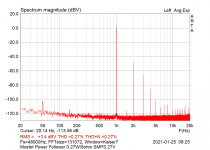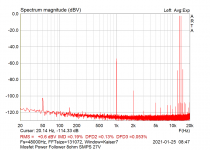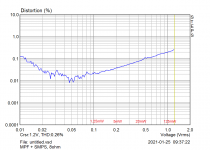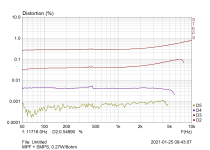So you would be saying that the burst non-linearity function with a sine or a twin-tone in "some tube circuits" would considerably differ, right? Any proof here?
Transformers can have level dependent frequency response (a form of non-stationarity) at low frequencies so conceivably a 100Hz THD and a 10/11kHz IMD could measure somewhat different. IME when this is present in a pre-amp or amp it is not pleasant. I see little point in using guitar amps, fuzz pedals, etc. as examples for the design of audio amps in general .
Thanks, such circuits have really been out of my scope and I really see no reason in using them in something we would like to call hi-fi.
I also love patents that start their background section with a discussion of how it is "well known" that the sound of no global feedback (or some equally silly claim) is preferred by critical listeners.
That's indeed a very un-scientific way to start things that I will never take for granted.
In this case however it is nothing but a thesis based on very positive reviews and measurements.
Reviews are very subjective and therefore potentially misleading, but when measurements can't be trusted it means that thesis is based on quicksand and manipulation.
I have still no opinion on this but do not want to talk things into the ground.
When it's all BS that with no global feedback IM can be very low despite high THD, it should be easy to prove, but I haven't seen such prove so far.
And I must laugh when people try place themselves at the same scientific level as you and Syn08.
Hans
but then the masters of measurements explained to me
🙄 Not a single one of the masters of measurements to quote. The usual bogeyman tactic noted.The SICRAP comparison graphs for example.
They clearly show the evolution of the audio reproduction along the last 50 years (old poor quality at the left against superb contemporary quality at the right.).
Subjective like the quote below?Reviews are very subjective and therefore potentially misleading,
"Even if this SE amp sounded just as good as a well designed SS amp"
🙄 Not a single one of the masters of measurements to quote. The usual bogeyman tactic noted.
I have pointed to the Lord of the Blue Screen, the master of the masters.
Is it not enough?
If you are not able to understand (although you are mother tongue) you can look at the picture:
- the crappy Sondek/Ittok/Benz vs the marvelous Okto DAC8
- the crappy 45 SET ampli vs the impressive Hypex NC400
- the crappy holey basket OB vs the fabulous Revel F35
I thought it was enough clear, crappy old audio devices with horrible measurements against well engineered contemporary audio devices with SOTA measurements.
Then I drawn the conclusion: "They clearly show the evolution of the audio reproduction along the last 50 years".
Audio has evolved immensely over the past 50 years.
Now is it clear?
When it's all BS that with no global feedback IM can be very low despite high THD, it should be easy to prove, but I haven't seen such prove so far.
It is difficult to properly model time variant or non-stationary processes. This is still a good reference on distortion of SIMPLE amplifiers.
https://www.its.caltech.edu/~musiclab/feedback-paper-acrobat.pdf
The Mosfet Power Follower (I should have been sin binned for designing and publishing this "amplifier" 20 years ago at Rod's pages). Long live the "NoGFB"!!
However, there is nothing unpredictable in the nonlinearity.
However, there is nothing unpredictable in the nonlinearity.
Attachments
Last edited:
Thanks, such circuits have really been out of my scope and I really see no reason in using them in something we would like to call hi-fi.
You are so closed minded Pavel! NOT! lolol I will admit to strongly believing for broadcast and recording studio use, quality transformers fix far more problems than they cause. Most of the "hifi" reference sources (CDs, LPs) people use to evaluate their audiophile equipment has gone through multiple line-level transformers in the studio. The minimum number of transformers in the signal path for most studios with all outboard equipment patched out is likely 2: channel strip input and Stereo mix output. This ignores the number of transformers during an initial multi-tracking which likely were many.
The issue with transformers is like the issue with feedback: proper implementation. For transformers the issues in application (not design) are sufficient core size, magnetic shielding, Zobel compensation and limited loading.
Cheers!
Howie
I will admit to strongly believing for broadcast and recording studio use, quality transformers fix far more problems than they cause.
Nah yeah but they were talking tube power amplifiers with level dependent frequency response. Quite a different case.
I will admit to strongly believing for broadcast and recording studio use, quality transformers fix far more problems than they cause.
I have seen R/L/C equalizers with tiny cores in the L's and they have plenty of artifacts that some recording engineers like. As for transformers you are right, they need to be specified for each application. The popular (with folks that can't afford the big names) Nakamichi CM300 had a tiny transformer that measured as well sounded just fine.
implementation. For transformers the issues in application (not design) are sufficient core size, magnetic shielding, Zobel compensation and limited loading.
Howie, do you agree with the Bill Whitlock application note on Jensen Transformers' website, that states the best way to choose Zobel compensation parts, is to optimize the output waveform in the time domain, seeking a Bessel response (zeta = 0.866)? Or do you tinker with Zobel parts while monitoring in the frequency domain?
I have repeated Cheever's test with the SE amp that Nelson Pass made available as a DIY kit just a few days ago having no feedback.
I used the same 200Hz +7Khz IM test that Cheever showed in his fig 1-18.
In the image below I first simulated the 200Hz and 7Khz separately, and finally combined them together in the lower plot of the three.
I used the same 400mV for both signals as he did, and in the third plot one can see that his thesis is completely nonsense, because the IM products have the same magnitude at -90dB as the harmonic distortion products.
Case closed.
Hans
.
I used the same 200Hz +7Khz IM test that Cheever showed in his fig 1-18.
In the image below I first simulated the 200Hz and 7Khz separately, and finally combined them together in the lower plot of the three.
I used the same 400mV for both signals as he did, and in the third plot one can see that his thesis is completely nonsense, because the IM products have the same magnitude at -90dB as the harmonic distortion products.
Case closed.
Hans
.
Attachments
Ed, I am all (shot) ears
George
George can it fly with those wings, err ears?
My point is that normal with age is the loss of high frequency hearing. Adding harmonics does to some extent stimulate apparent HF perception.
Altec Lansing used to recommend rolling off the high frequency response of their systems by 3 dB per octave IIR from 3,000 hertz and higher. If that was due to increased distortion, lack of capability or just some folks preference is subject to speculation. They called this a house curve.
Later on I can find where the rolloff point was raised to 10,000 hertz.
http://alteclansingunofficial.nlenet.net/publications/techletters/TL_241.pdf
Last edited:
And at the same time, when you are right for this special case , the Uni of New Hampshire has agreed on the publication of a 86 pages paper with completely wrong conclusions based on completely wrong measurements and assumptions.
How likely is that, would be bad for their reputation.
Can't won't speak much to the simulations part, but having spent too long in academia, I can assure you no one is paying any attention to a master's thesis. Only the rare, incredible, Ph.D thesis may make a splash, but more likely the publications the thesis is based on. So no reputation at stake.
Ed 
I had placed a bet on the flavor of your explanation.
(your description of how you made use of stones to combat Covid will never fade away in my memory)
George

I had placed a bet on the flavor of your explanation.
(your description of how you made use of stones to combat Covid will never fade away in my memory)
George
Pavel, For amps with substantial amounts of feedback I fully agree.
But in case of having none feedback at all I have no idea, that's why I will attempt to do some LTSpice sims, maybe leading to get a better feeling.
And at the same time, when you are right for this special case , the Uni of New Hampshire has agreed on the publication of a 86 pages paper with completely wrong conclusions based on completely wrong measurements and assumptions.
How likely is that, would be bad for their reputation.
Maybe someone like Syn08 could shine his light on this, one of the few whose knowledge I trust.
Pavel is correct. Harmonic distortions and intermodulation distortions are not independent variables, they are mathematically directly related. Sketch of proof: consider one or more "non linearity functions" and their Taylor series expansion around the bias point (which always exist, since in the time invariant case, such "non linearity functions" are infinitely derivable). Retain as many terms as you want to approximate the nonlinearities, the less feedback, the more you need (since the excursion around the bias point increase). Since the result is a sum of power series, calculating the resulting IMD is only a matter of trigonometry (horrible, practically impossible to manage other than for the first 2-3 terms of a single non linearity, which is what for example Baxandall did). Moreover, the Borel theorem tells us that ANY such expansion has a "non linearity function" it originates from, so there are no "holes" (that is, amplifiers which would not obey this result).
The time variant case is a different story, and for all purposes except fancying Markw4 it can be safely ignored. Pathological tubes amplifiers examples (if they exist) are not interesting, although the proud owners of a Wavac toy may protest.
Can't won't speak much to the simulations part, but having spent too long in academia, I can assure you no one is paying any attention to a master's thesis. Only the rare, incredible, Ph.D thesis may make a splash, but more likely the publications the thesis is based on. So no reputation at stake.
Stephen Hawking's thesis comes to mind, after that he was instantly offered a PhD track which he completed in less than 2 years (Master + PhD 1962-1966).
- Home
- Member Areas
- The Lounge
- The Black Hole......






